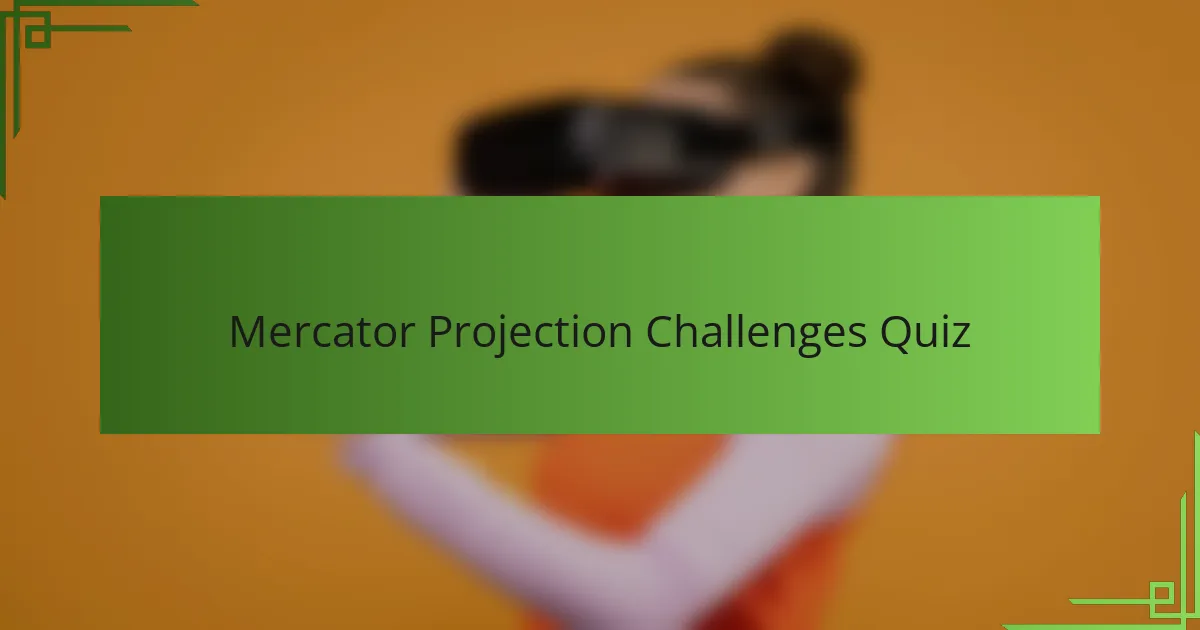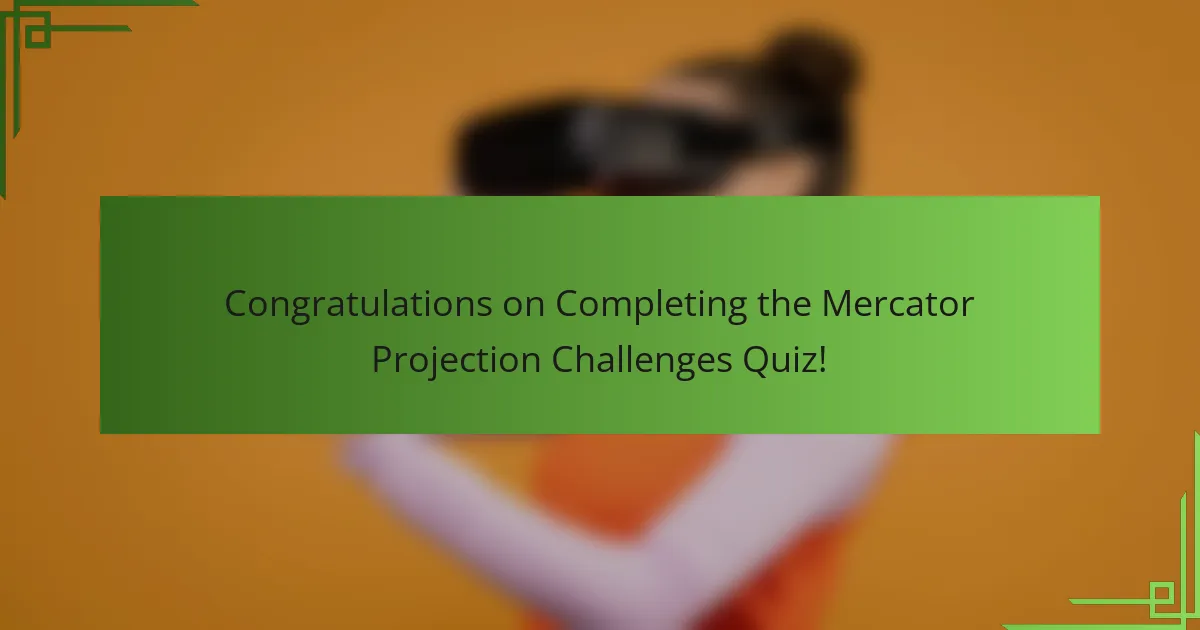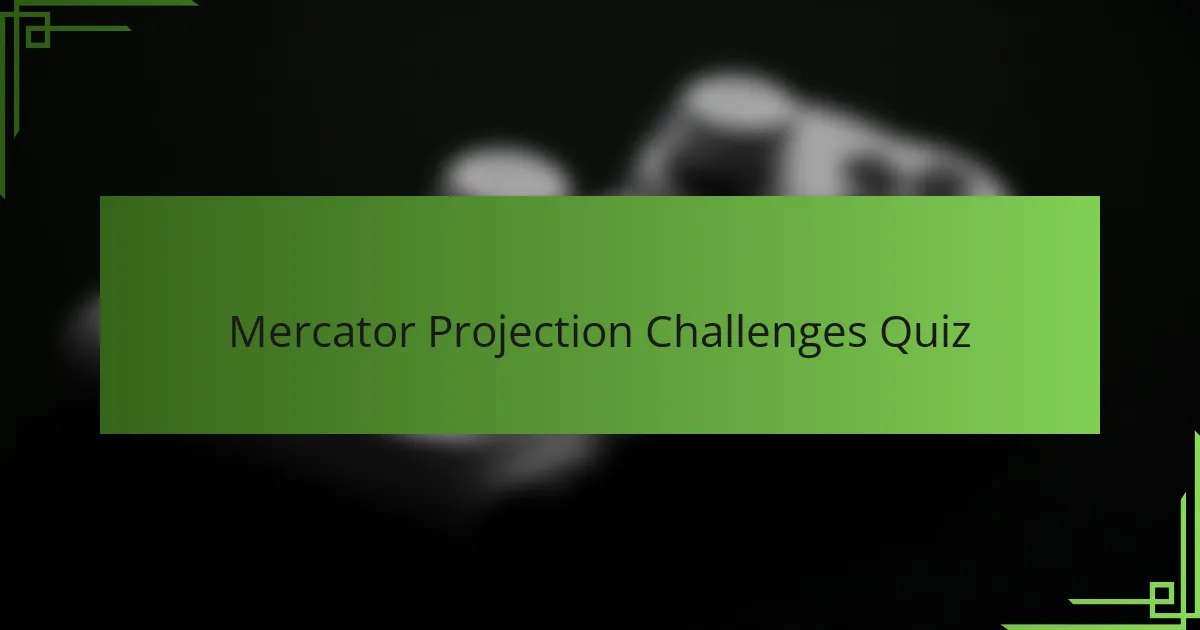
Mercator Projection Challenges Quiz
1. What distortion issue is the Mercator projection most known for in representing sizes of landmasses?
- Compression of coastal outlines
- Size exaggeration of landmasses near the poles
- Distortion of equatorial distances
- Misalignment of continent shapes
2. Which continent appears significantly larger than it is on a Mercator map due to projection distortions?
- Australia
- Antarctica
- Greenland
- South America
3. How does the Mercator projection affect the perceived size of Greenland compared to Africa?
- The Mercator projection depicts Greenland and Africa roughly the same size due to equal area scaling.
- The Mercator projection shrinks Greenland’s size in relation to Africa to maintain real-world proportions.
- The Mercator projection makes Africa appear larger than it actually is, relative to Greenland.
- The Mercator projection greatly enlarges Greenland’s perceived size compared to Africa.
4. What is the primary use of the Mercator projection in navigation despite its distortion challenges?
- To represent lines of constant compass bearing as straight lines
- To minimize area distortion across continents
- To provide the most accurate depiction of polar regions
- To display true distances between all global points
5. Which ocean`s route appears more accurately on a Mercator projection compared to other projections?
- North Atlantic Ocean
- Indian Ocean
- Southern Ocean
- South Pacific Ocean
6. In what way does the Mercator projection misrepresent the poles on a world map?
- It shifts the poles towards the equator but maintains relative size
- It accurately represents the poles but distorts only the equatorial regions
- It compresses the landmasses near the poles making them appear smaller
- It greatly exaggerates the size of landmasses near the poles
7. Which famous cartographer created the Mercator projection in 1569?
- Abraham Ortelius
- Sebastian Münster
- Gerardus Mercator
- Gerard de Jode
8. Why is Antarctica greatly exaggerated in size on a Mercator projection map?
- Antarctica appears larger because the map scales distances equally across all latitudes.
- The projection enlarges Antarctica due to its extensive ice coverage reflecting more light.
- The Mercator projection inflates sizes of landmasses near the poles to preserve direction and shape.
- Antarctica is exaggerated in size because the projection prioritizes preserving area over angles.
9. How does the Mercator projection challenge educators when teaching world geography?
- It inaccurately represents the shape of continents, causing confusion about their true outlines.
- It reverses the north and south hemispheres, which misleads students about global orientation.
- It distorts the size of landmasses, making regions near the poles appear disproportionately large.
- It omits certain countries entirely, leading to an incomplete understanding of world geography.
10. What alternative projection is often suggested to address the size distortion problems of the Mercator projection?
- Robinson projection
- Gall-Peters projection
- Winkel Tripel projection
- Mercator transversale projection
11. Which U.S. state appears larger than Africa on a Mercator map due to distortion?
- Montana
- Alaska
- California
- Texas
12. How does the Mercator projection affect perceptions of countries near the equator?
- It underrepresents their size, making equatorial countries appear smaller than they actually are.
- It enlarges their size disproportionately, exaggerating their actual area on the map.
- It flips their position, placing equatorial countries in polar regions.
- It accurately maintains their size but distorts their shapes significantly.
13. Why is the Mercator projection less useful for understanding true global population distribution?
- It eliminates the visibility of many small island nations, causing an incomplete view of global population spread.
- It greatly distorts the size of landmasses near the poles, making areas like Canada and Russia appear larger than they are and skewing population density perception.
- It understates the importance of urban centers by reducing the relative size of densely populated cities globally.
- It uses a non-linear scale that exaggerates population counts in equatorial regions due to curvature adjustments.
14. What type of map projection maintains accurate angles, making it useful for marine navigation?
- Mercator projection
- Winkel Tripel projection
- Robinson projection
- Gall-Peters projection
15. How have modern digital mapping services adapted or avoided traditional Mercator projection challenges?
- They switch to the Gall-Peters projection exclusively for all maps.
- They avoid projections by displaying only satellite images without maps.
- They use alternative projections like Web Mercator that reduce distortion for online viewing.
- They strictly use the traditional Mercator projection without modification.

Congratulations on Completing the Mercator Projection Challenges Quiz!
Thank you for engaging with this quiz on the Mercator projection and its challenges. Through the questions, you have explored the distortions and limitations inherent in this popular map projection. You’ve likely gained insights into how the Mercator projection stretches areas near the poles and why this affects our perception of world geography.
Understanding these challenges is important for anyone interested in geography. It highlights the complexities involved in representing our round Earth on flat surfaces. By recognizing these distortions, you are better equipped to critically analyze maps and the information they convey. This knowledge helps in appreciating alternative map projections and their unique strengths.
For those eager to deepen their understanding, we invite you to visit the next section on this page. There, you will find detailed information about the Mercator projection, including its history, uses, and the ongoing discussions in cartography. This will expand your geographical knowledge and enhance your appreciation of map-making as both an art and a science.

Mercator Projection Challenges
Overview of the Mercator Projection in Geography
The Mercator projection, developed by Gerardus Mercator in 1569, is a cylindrical map projection widely used for navigation. It represents the globe on a flat surface by projecting meridians and parallels as straight lines perpendicular to each other. This projection preserves angles, making it ideal for marine navigation, but it distorts sizes and shapes, especially near the poles. Its use in geographical representation is significant, but it introduces various challenges related to distortion and accuracy.
Size Distortion Challenges in the Mercator Projection
The Mercator projection severely distorts the size of landmasses as latitude increases. For example, Greenland appears comparable in size to Africa, despite Africa being about 14 times larger. This distortion arises because the projection stretches areas near the poles to maintain accurate angles. This size distortion challenges geographical interpretations, causing misconceptions about the relative scale of countries and continents.
Impact on Perception of Global Geography
The distorted representation of landmasses on the Mercator map affects public perception of global geography. Countries in higher latitudes such as Canada and Russia appear larger than their actual size, while equatorial countries like those in Africa and South America appear smaller. This skewed perception influences education, media representations, and geopolitical understanding, leading to potential biases in how regions are viewed globally.
Limitations for Representing Polar Regions
The Mercator projection poorly represents the polar regions due to extreme distortion. Both the North and South Poles are shown as lines rather than points, resulting in inaccurate portrayal of polar geography and ice-covered areas. This makes the projection unsuitable for studies and maps focusing on the Arctic and Antarctic, where other projections like the polar stereographic are more effective for accuracy.
Alternatives Developed to Address Mercator Projection Challenges
To counteract Mercator’s distortions, geographers developed alternative projections. The Gall-Peters projection emphasizes area accuracy, scaling landmasses more realistically. The Robinson projection offers a compromise, balancing size and shape distortions for better visual appeal. Such alternatives demonstrate efforts by cartographers, including Arno Peters and Arthur H. Robinson, to create maps that mitigate the Mercator projection’s challenges while serving different geographical purposes.
What are the primary challenges of the Mercator projection in geography?
The primary challenges of the Mercator projection include distortion of size, especially near the poles, where landmasses appear much larger than they are in reality. For example, Greenland appears comparable in size to Africa, though Africa is about 14 times larger. This distortion affects accurate spatial representation and misleads perceptions of geographic size and distance.
How does the Mercator projection distort landmass sizes?
The Mercator projection enlarges areas farther from the equator due to its cylindrical map projection technique that preserves angles but not area. This results in polar regions appearing disproportionately large compared to equatorial regions. This distortion increases progressively with latitude, which is mathematically proven by the way the projection stretches latitude lines.
Where is the Mercator projection most inaccurate?
The Mercator projection is most inaccurate near the poles, specifically above 60 degrees latitude north and south. In these areas, the scale factor grows exponentially, causing extreme exaggeration of the size of continents like Greenland and Antarctica compared to regions near the equator.
When was the Mercator projection created and who invented it?
The Mercator projection was created in 1569 by Gerardus Mercator, a Flemish geographer and cartographer. Its original purpose was to assist navigation by preserving accurate compass bearings, a fact documented in historical cartographic records.
Who primarily uses the Mercator projection despite its challenges and why?
Marine navigators and some online mapping services primarily use the Mercator projection because it preserves angles and directions, which is essential for charting straight-line courses in navigation. This functional advantage outweighs its distortions for these specific applications, as noted in maritime navigation standards and cartographic textbooks.
